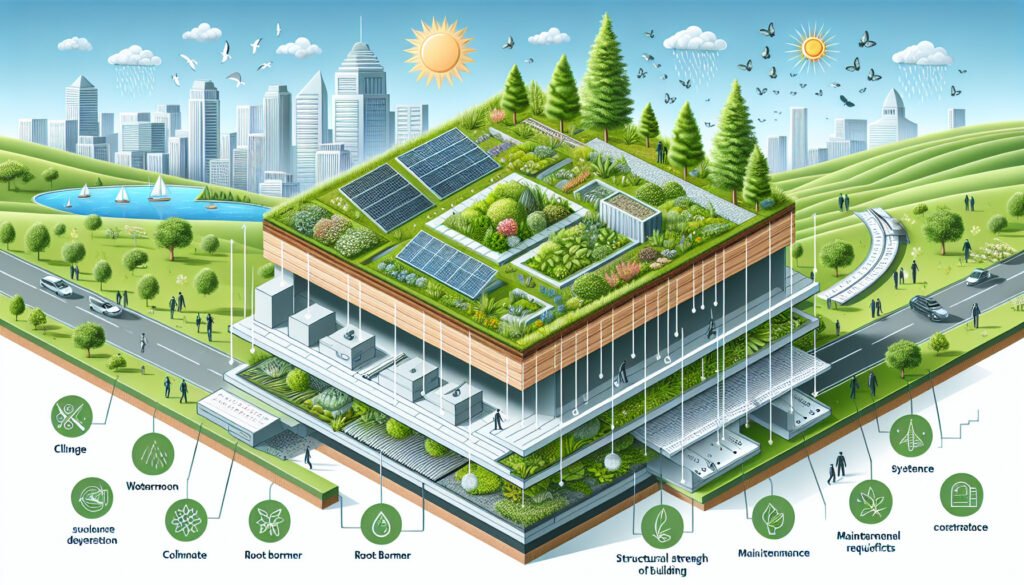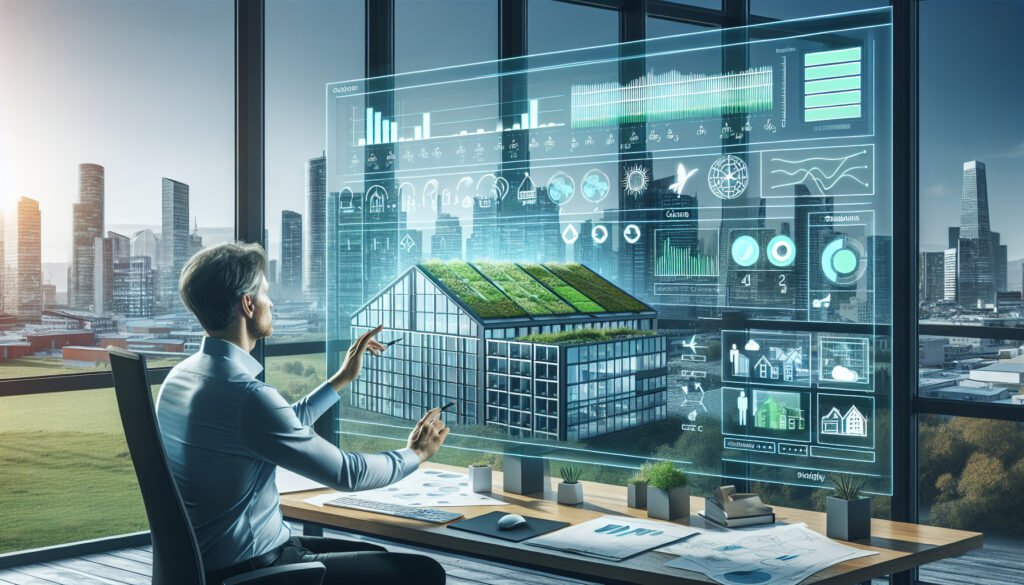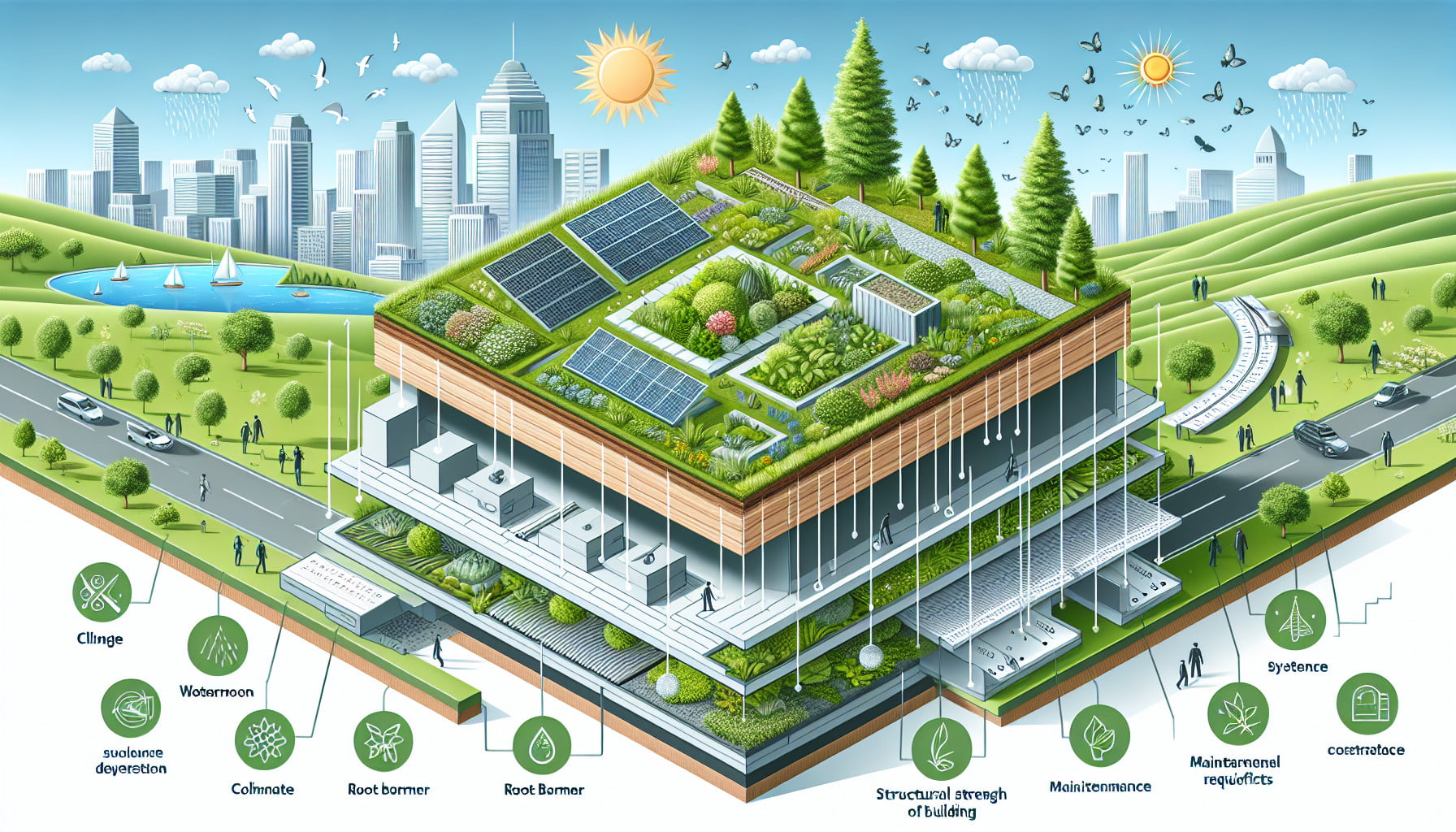Imagine you are the proud owner of a building and you can’t help but notice the growing trend of green roofs in your city. You’ve done your research and you’re intrigued by the numerous benefits they offer – from reducing energy costs to improving air quality. The only problem is, you’re not quite sure where to start when it comes to choosing the right green roof system for your building.
Don’t fret, because in this article, we’ll guide you through the process of selecting the perfect green roof system that not only aligns with your building’s structure but also meets your sustainability goals. Let’s get started!
Factors to Consider Before Choosing a Green Roof System
Climate and Environmental Conditions
Before choosing a green roof system, it is important to consider the climate and environmental conditions of the area where your building is located. Factors such as temperature, rainfall, and wind patterns can significantly impact the performance and longevity of your green roof. For instance, if you live in a region with extreme heat or cold, you may need a green roof system that offers better insulation. Similarly, if your area receives heavy rainfall, you should opt for a green roof system with excellent drainage capabilities to prevent waterlogging.
Building Structure and Load-Bearing Capacity
The structural integrity of your building is a critical factor to consider when selecting a green roof system. It is essential to ensure that your building has the necessary load-bearing capacity to support the additional weight of the green roof system, vegetation, and any potential accumulation of water or snow. Consulting with a structural engineer can help determine the maximum weight your building can withstand and guide you in choosing a green roof system that is compatible with your building’s structure.
Building Purpose and Function
The purpose and function of your building play a significant role in determining the type of green roof system you should choose. If you have a commercial building, you may want to consider a green roof system that offers additional insulation, noise reduction, and enhanced aesthetics to create a pleasant environment for employees and customers. On the other hand, if you have a residential building, you may prioritize a green roof system that allows for recreational space or gardening opportunities. Understanding the intended use of your building is crucial in selecting the right green roof system to meet your specific needs.
Budget and Cost Considerations
Budget and cost considerations are always important when making any building-related decisions, including choosing a green roof system. It is essential to evaluate the upfront costs of installation, as well as the long-term maintenance and operational expenses associated with different green roof systems. While extensive green roofs are generally more cost-effective and easier to maintain, intensive green roofs offer more flexibility and aesthetic appeal. By carefully considering your budget and cost constraints, you can choose a green roof system that aligns with your financial goals and long-term sustainability objectives.
Different Types of Green Roof Systems
Extensive Green Roofs
Extensive green roofs are lightweight and require minimal maintenance. These systems consist of low-growing vegetation, such as sedums and grasses, planted in shallow soil layers. Due to their shallow soil depth, extensive green roofs have a lower weight load and are suitable for buildings with limited load-bearing capacities. They provide excellent stormwater management, insulation, and energy efficiency benefits.
Intensive Green Roofs
Intensive green roofs are more like traditional gardens, as they allow for the growth of a wide variety of plants, including shrubs and small trees. These green roofs have deeper soil layers, which support a diverse range of plant species and create lush landscapes. However, intensive green roofs require regular maintenance and have a higher weight load, making them suitable for buildings with strong load-bearing capacities and dedicated caretaking.
Semi-Intensive Green Roofs
Semi-intensive green roofs combine elements of extensive and intensive green roofs. They offer a balance between ease of maintenance and the ability to grow a broader range of plants. These green roof systems typically have a medium-depth soil layer that can accommodate a variety of vegetation. Semi-intensive green roofs are suitable for buildings that can withstand a moderate weight load and require moderate maintenance.

Types of Vegetation and Planting Methods
Sedum Mats and Sedum Plugs
Sedum mats and sedum plugs are popular options for extensive green roof systems. Sedums are low-growing succulent plants that are drought-tolerant and low-maintenance. Sedum mats consist of pre-grown sedum plants on a mat-like structure, making installation quick and easy. Sedum plugs are individual sedum plants that can be planted directly into the green roof substrate. Both options provide instant greenery and require minimal watering and maintenance.
Wildflower Meadows
Creating a wildflower meadow on your green roof offers a beautiful and natural aesthetic while providing valuable habitat for pollinators. Wildflower meadows typically consist of a mixture of native wildflowers and grasses that are adapted to the local climate. These green roof systems require moderate maintenance, including occasional mowing and weeding to ensure the meadow remains diverse and healthy.
Grasses and Herbaceous Plants
Grasses and herbaceous plants are commonly used in extensive and semi-intensive green roofs. They are resilient, low-maintenance, and provide year-round visual interest. Ornamental grasses, such as fescue and feather reed grass, are ideal for their ability to withstand diverse environmental conditions. Herbaceous plants, such as flowering perennials, add color and texture to the green roof while attracting pollinators.
Shrubs and Small Trees
In the case of intensive green roofs, shrubs and small trees can be incorporated, creating a more landscaped and garden-like atmosphere. Shrubs add depth and dimension to the green roof while providing additional environmental benefits, such as enhanced biodiversity and improved air quality. Small trees, such as fruit trees or flowering trees, offer aesthetic appeal, shade, and potential food production, but may require more maintenance and care.
Planting Techniques
There are various planting techniques for green roofs, depending on the chosen vegetation and green roof system. Transplanting pre-grown vegetation, such as sedum mats or wildflower plugs, is a popular and efficient method for extensive green roofs. For intensive green roofs, using container-grown plants allows for greater flexibility in creating desired plant layouts and arrangements. Additionally, direct-seeding is an option for certain types of vegetation, but it may take longer for the green roof to establish.
Waterproofing and Drainage Systems
Built-In Waterproofing
Built-in waterproofing is a critical component of any green roof system, as it protects the underlying structure from water infiltration. There are several waterproofing options available, including asphalt-based membranes, liquid applied membranes, and rubber membranes. It is important to choose a waterproofing system that is specifically designed for green roofs and provides long-lasting protection against leaks and water damage.
Root-Resistant Membranes
Root-resistant membranes are used to prevent plant roots from penetrating the waterproofing layer and potentially causing damage. These membranes serve as a protective barrier between the vegetation and the waterproofing system. When selecting a root-resistant membrane, it is crucial to choose a material that is durable, flexible, and resistant to root penetration, ensuring the longevity of both the green roof and the building’s structure.
Drainage Mats and Layers
Proper drainage is essential to prevent water accumulation on the green roof and to ensure the health of the plants. Drainage mats and layers, typically made from geotextile fabrics, are installed between the soil layers and the waterproofing layer. These materials allow excess water to drain efficiently while retaining an adequate amount of moisture for the plants. Choosing drainage mats with high water retention and drainage capacity is crucial for the proper functioning of the green roof system.
Water Retention Layers
Water retention layers are used to regulate moisture levels in the green roof system. These layers, often made from porous materials like expanded clay pellets or geotextile fabrics, help retain water for the plants during dry periods while allowing excess water to drain away. The selection of the water retention layer depends on the specific water requirements of the chosen vegetation and the climate conditions in the area.

Maintenance and Accessibility
Accessibility for Inspection and Maintenance
When choosing a green roof system, it is important to consider its accessibility for inspection and maintenance tasks. Regular inspection of the green roof is necessary to ensure proper functioning and identify any issues that may arise. Accessibility can be improved by including walkways or pavers that allow easy movement across the green roof. Additionally, providing access points for equipment and establishing a routine maintenance schedule will help ensure the longevity and performance of the green roof system.
Irrigation Systems
Proper irrigation is essential for the health and vitality of the green roof vegetation, particularly during dry periods. Irrigation systems can range from simple manual watering to complex automated systems with timers and sensors. The choice of irrigation system depends on the specific water requirements of the plants and the availability of water sources. Installing an efficient irrigation system will help maintain optimal moisture levels and promote plant growth on the green roof.
Weed Control
Weed control is an important aspect of green roof maintenance. Unwanted vegetation can compete with the desired plants for water, nutrients, and space, potentially compromising the health and appearance of the green roof. Implementing effective weed control measures, such as regular weeding, mulching, and the use of pre-emergent herbicides, can help keep the green roof free from invasive weeds and ensure the dominance of the chosen vegetation.
Fertilization and Nutrient Management
Proper fertilization and nutrient management are essential for the long-term health and vitality of the green roof vegetation. Green roofs typically have limited soil depths, which may restrict the availability of nutrients. Regularly monitoring nutrient levels and providing appropriate fertilizers or organic amendments can help ensure that the plants receive the necessary nutrients to thrive. It is important to select fertilizers that are specifically formulated for green roofs to avoid nutrient imbalances or water pollution.
Pruning and Trimming
Pruning and trimming are necessary maintenance tasks for green roofs with shrubs and small trees. Regularly pruning the vegetation helps maintain its shape, promote healthy growth, and prevent overcrowding. It is important to consider the growth habits and requirements of the chosen plants when planning for pruning and trimming. Creating a regular pruning schedule and employing proper pruning techniques will help retain the desired aesthetic and health of the green roof vegetation.
Sustainability and Environmental Benefits
Stormwater Management
One of the significant environmental benefits of green roofs is their ability to manage stormwater. Through their vegetation and drainage systems, green roofs can absorb and retain rainwater, reducing the volume and intensity of stormwater runoff. This helps alleviate pressure on stormwater infrastructure and reduces the risk of urban flooding. Additionally, green roofs can filter and purify rainwater, removing pollutants and improving water quality before it enters the municipal water system.
Improved Air Quality
Green roofs contribute to improved air quality in urban areas by acting as natural air filters. The vegetation on green roofs absorbs airborne pollutants, such as carbon dioxide and particulate matter, and releases oxygen through the process of photosynthesis. This helps reduce the concentration of pollutants in the air and mitigate the impact of urban pollution. The presence of green roofs can also reduce the heat-island effect, which further enhances air quality by lowering ambient temperatures.
Reduced Urban Heat Island Effect
The urban heat island effect is a phenomenon in which urban areas experience higher temperatures compared to rural areas due to the abundance of concrete, asphalt, and buildings that absorb and radiate heat. Green roofs can help mitigate the urban heat island effect by providing natural insulation, reducing solar heat gain, and increasing evaporative cooling through transpiration. The vegetation on green roofs also reflects sunlight, further lowering surface temperatures and creating a more comfortable microclimate.
Enhanced Biodiversity
Green roofs provide valuable habitat and food sources for birds, bees, butterflies, and other pollinators. By introducing diverse plant species and creating mini-ecosystems, green roofs contribute to the conservation of local biodiversity. The presence of green roofs can help support urban wildlife populations, promote pollination of nearby plants, and create ecological corridors within urban landscapes. Green roofs also serve as stepping stones for migratory bird species, as they provide rest stops and foraging opportunities.
Green Roof Design and Aesthetics
Overall Design Goals
When designing a green roof, it is essential to establish clear goals and objectives. Consider the desired aesthetic appeal, functionality, and integration with the surrounding landscape. Determine whether the green roof will be primarily ornamental or if it will serve additional purposes, such as recreational spaces or wildlife habitats. By defining the design goals, you can ensure that the green roof system will meet your expectations while aligning with the overall vision for the building.
Integration with Surrounding Landscape
Green roofs should be designed to harmonize and integrate with the surrounding landscape. Consider the existing vegetation, architectural style, and natural elements to create a cohesive and visually appealing green roof. Pay attention to color palettes, textures, and plant selection to complement the surroundings. Design elements such as paths, seating areas, and focal points can enhance the integration and create inviting spaces for building occupants and visitors.
Aesthetics and Visual Appeal
The aesthetic qualities of a green roof are essential for creating an appealing and inviting environment. Carefully select plant species and arrangements that provide pleasing colors, textures, and year-round visual interest. Consider the overall layout, proportion, and balance of the green roof to create an aesthetically pleasing composition. Incorporating elements such as container gardens, raised beds, or vertical plantings can add depth and variety to the visual appeal of the green roof.
Professional Expertise and Support
Consulting with Green Roof Specialists
Seeking professional expertise and support is crucial when choosing a green roof system. Green roof specialists can provide valuable advice on the selection of appropriate green roof components, plant species, and maintenance practices. They can assess the unique characteristics and requirements of your building and guide you in making informed decisions. Working with green roof specialists ensures that you receive comprehensive and tailored recommendations for your specific needs.
Hiring a Qualified Roofing Contractor
To ensure the successful installation of your green roof system, it is important to hire a qualified and experienced roofing contractor. Green roofs require specialized knowledge and skills, as they involve unique construction techniques and materials. Look for contractors who have prior experience in installing green roofs and can provide references from previous green roof projects. Before finalizing the contract, verify the contractor’s certifications and insurance coverage to guarantee a safe and professional installation.
Case Studies and Success Stories
Examining Real-World Green Roof Installations
Examining real-world green roof installations can provide valuable insights and inspiration for choosing the right green roof system. Explore case studies of green roofs in your region or similar climatic conditions to understand their performance, challenges, and benefits. Pay attention to the specific design considerations, maintenance practices, and environmental outcomes of these projects. Learning from successful green roof installations can help you make informed decisions and anticipate potential issues.
Learning from Industry Best Practices
Green roof industry best practices provide guidelines and standards that ensure the quality and effectiveness of green roof systems. Stay informed about the latest advancements, research findings, and industry recommendations through professional organizations, conferences, and publications. Familiarize yourself with the best practices related to waterproofing, drainage, vegetation selection, maintenance, and performance monitoring. Incorporating industry best practices into your decision-making process will help optimize the functionality and longevity of your green roof system.
Permits, Regulations, and Building Codes
Local Municipality Regulations
Before installing a green roof system, it is important to be aware of the local municipality regulations and guidelines. Local authorities may have specific requirements regarding building permits, stormwater management, fire safety, and structural considerations. Familiarize yourself with the relevant regulations and follow the necessary processes to obtain the required permits and approvals. Failure to comply with local regulations can result in legal issues and delays in the construction or operation of the green roof.
Building Code Standards
Green roof systems must meet the building code standards established by local and national authorities. Building codes define the minimum requirements for structural integrity, fire safety, insulation, and other relevant factors. It is essential to consult with a qualified structural engineer or architect to ensure that your green roof system complies with the applicable building code standards. Building code compliance ensures the safety and functionality of your green roof and minimizes potential risks.
Permitting and Approval Processes
The permitting and approval processes for green roof installations can vary depending on the location and specific circumstances. Contact the local building department or planning authority to understand the necessary steps and documentation required for obtaining permits and approvals. Prepare the necessary plans, specifications, and supporting documents to facilitate the permitting process. Engaging with local authorities early in the planning stage will help streamline the permitting process and ensure compliance with all regulations and requirements.
Choosing the right green roof system for your building involves careful consideration of various factors, from climate conditions and building structure to budget constraints and maintenance requirements. By understanding the different types of green roof systems, vegetation options, and design considerations, you can make an informed decision that aligns with your goals for sustainability, environmental benefits, and overall aesthetics. Seeking professional expertise, learning from successful case studies, and complying with local regulations will further support the successful implementation of your green roof system.

